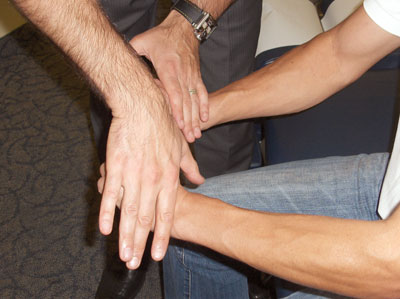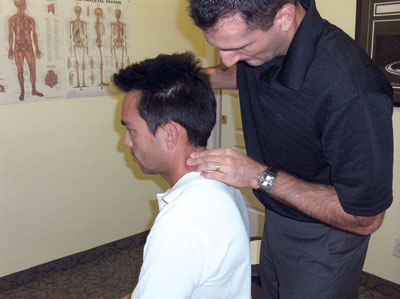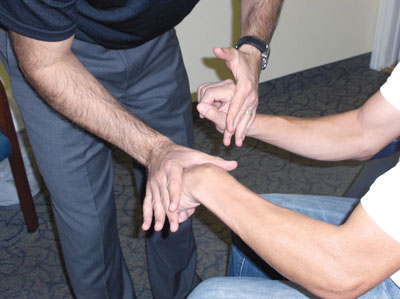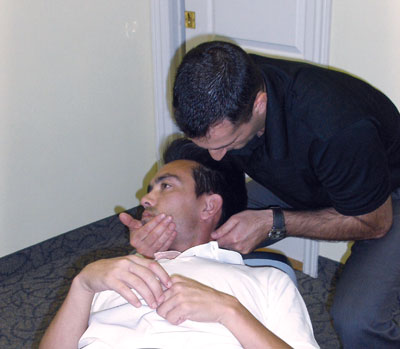
A special thank-you goes to Dr. Jay Grossman of Toronto, Ontario, for his contribution to this article.
A special thank-you goes to Dr. Jay Grossman of Toronto, Ontario, for his contribution to this article.
 |
|
| Picture 1. Doctor applies a caudad pressure to the dorsum of the hand bilaterally. Normally, the patient maintains strong wrist extension. A hidden cervical disc may be present when the patient exhibits a weakness with wrist extension. |
|
 |
|
| Picture 2: Doctor applies anterior-superior pressure to the transverse processes of the cervical spine, to detect the level of involvement. | |
 |
|
| Picture 3: When the vertebra above the level of the disc involvement is challenged, the wrist extensor muscle will test weak. |
|
 |
|
| Picture 4: Supine correction for a hidden cervical disc is displayed. Note that the Index Finger DIP contact is on the spinous process inferior to the involved disc level. (This is the segment below the challenged vertebra that produced weakness in the extensor muscle test.) Advertisement
|
SAMPLE CASE
A 40-year-old male construction worker presents to the clinic with neck pain and intermittent radiation into the left shoulder. He informs the doctor that the pain started after an object fell and struck him on the top of his head approximately three years ago. He also mentions that since the incident, he notices that he has trouble gripping an object for more than a few minutes, before fatigue sets into his left forearm. At the time of the incident, the patient indicates that he received cervical X-rays, was told that no fractures were present, and that the injury was a muscle strain. He was given a prescription for muscle relaxants, which alleviated the symptoms for a short while, but when the prescription expired, the pain returned. Physical examination reveals a decrease in cervical flexion and lateral flexion to the left. Palpation reveals subluxations present at C5, C6 and C7 on the left. Axial compression of the cervical spine slightly reproduces the radiation into the left shoulder. All other neurological and x-ray analyses are unremarkable.
For chiropractors trained in applied kinesiology, this sample case is a familiar potential clinical scenario for what is referred to as a “hidden cervical disc.” In this edition of Technique Toolbox, I will explain this phenomenon, the analysis required to detect it, and how to correct this subluxation.
BUT FIRST, SOME HISTORY
Applied kinesiology (AK) is a system that evaluates structural, chemical and mental aspects of health using manual muscle testing combined with other standard methods of diagnosis. Treatments may involve specific joint manipulation or mobilization, various myofascial therapies, cranial techniques, meridian and acupuncture skills, clinical nutrition, dietary management, counseling skills, evaluation for environmental irritants and various reflex procedures.1
The practice of AK requires that it be used in conjunction with other standard diagnostic methods by professionals trained in clinical diagnosis. As such, the use of AK, or its constituent assessment procedures, is appropriate only for individuals licensed to perform those procedures.1
The origin of contemporary applied kinesiology is traced to 1964 when George J. Goodheart, Jr., D.C., first observed that in the absence of congenital or pathologic anomaly, postural distortion is often associated with muscles that fail to meet the demands of testing designed to maximally and specifically isolate and evaluate them. Thus, muscle testing became an integral part of the evaluation procedure and manipulation of these areas of apparent muscle dysfunction improved both postural balance and the outcome of manual muscle tests.1
With respect to scenarios similar to our sample case, Goodheart postulated that some cervical spine pain and radicular problems could result from laxity of the annulus fibrosis, causing an intervertebral disc bulge. He felt that weakness of the neck extensors and increased tonicity of the neck flexors, especially the scalenes, leads to the weight of the head bearing down on the vertebra causing it to slide anterior superior along the facet line. He does not consider this is a true herniation; rather, it is a “hidden cervical disc” problem. The mechanism responsible appears to be an anterior cervical subluxation.2
SO, HOW DO WE DETECT A HIDDEN CERVICAL DISC?
| Step 1: General Analysis (See Picture 1) | |
| • |
Doctor applies caudal pressure on the vertex of the head (applying axial compression to the disc). |
| • | Muscle testing is applied to the wrist extensors – Doctor instructs patient to bend arms to 90 degrees, close both hands and extend both wrists. Doctor applies a caudad pressure to the dorsum of the hand bilaterally. |
| • | Normally, the patient can successfully resist the caudad pressure, and maintains strong wrist extension. |
| • | A hidden cervical disc is present when the patient exhibits a weakness with the wrist extension muscle testing, following the application of caudad pressure to the vertex of the head. |
| Step 2: Specific challenge to locate the level of involvement (See Pictures 2 and 3) |
|
| • | Doctor applies pressure to the transverse process in an anterior superior direction. |
| • | When the vertebra above the level of the disc involvement is challenged, the wrist extensor muscle will test weak. |
| • | The challenge may be positive bilaterally or unilaterally. Pain will also be present at the spinous process of the segment below the hidden cervical disc. |
| Step 3: Supine Correction (See Picture 4) | |
| • | Doctor: Head of the table. |
| • | Patient: Supine. |
| • | Contact: Index Finger DIP contact on the spinous process inferior to the involved disc level. (This will be the segment below the challenged vertebra that produced weakness in the extensor muscle test). |
| • | Stabilization: Cradling patient’s head in forearm, hand wrapped around chin allowing the doctor to traction the cervical spine while stabilizing the vertebra below the hidden disc. |
| • | LOC: Posterior inferior (always opposite of the positive challenge). |
Depending upon the challenge present, one or both sides may need to be adjusted. If the challenge is positive bilaterally, first adjust the side with the maximum weakening on challenge. Following the adjustment, challenge the disc to determine if correction was successful. A successful correction will result in a lack of weakness in the wrist extensor muscle testing following the hidden cervical disc challenge. There should also be a reduction of pain at the spinous process.2
The use of applied kinesiology to help detect and correct hidden subluxations is a tool that we should all have in our technical toolbox. As usual, I have only scratched the surface in explaining this technique. If you would like to learn more about applied kinesiology, please go to www.icakusa.com. If you have any questions or comments, please contact me at johnminardi@hotmail.com. Until next time . . . adjust with confidence!
References:
1. www.icakusa.com
2. Walther, DS. Applied kinesiology synopsis, 2nd edition, Pueblo, CO: Systems DC; 2000.
Dr. John Minardi is a 2001 graduate of Canadian Memorial Chiropractic College. A Thompson-certified practitioner and instructor, he is the creator of the Thompson Technique Seminar Series and author of The Complete Thompson Textbook – Minardi Integrated Systems. In addition to his busy lecture schedule, Dr. Minardi operates a successful private practice in Oakville, Ontario. E-mail johnminardi@hotmail.com, or visit www.ThompsonChiropracticTechnique.com
Print this page